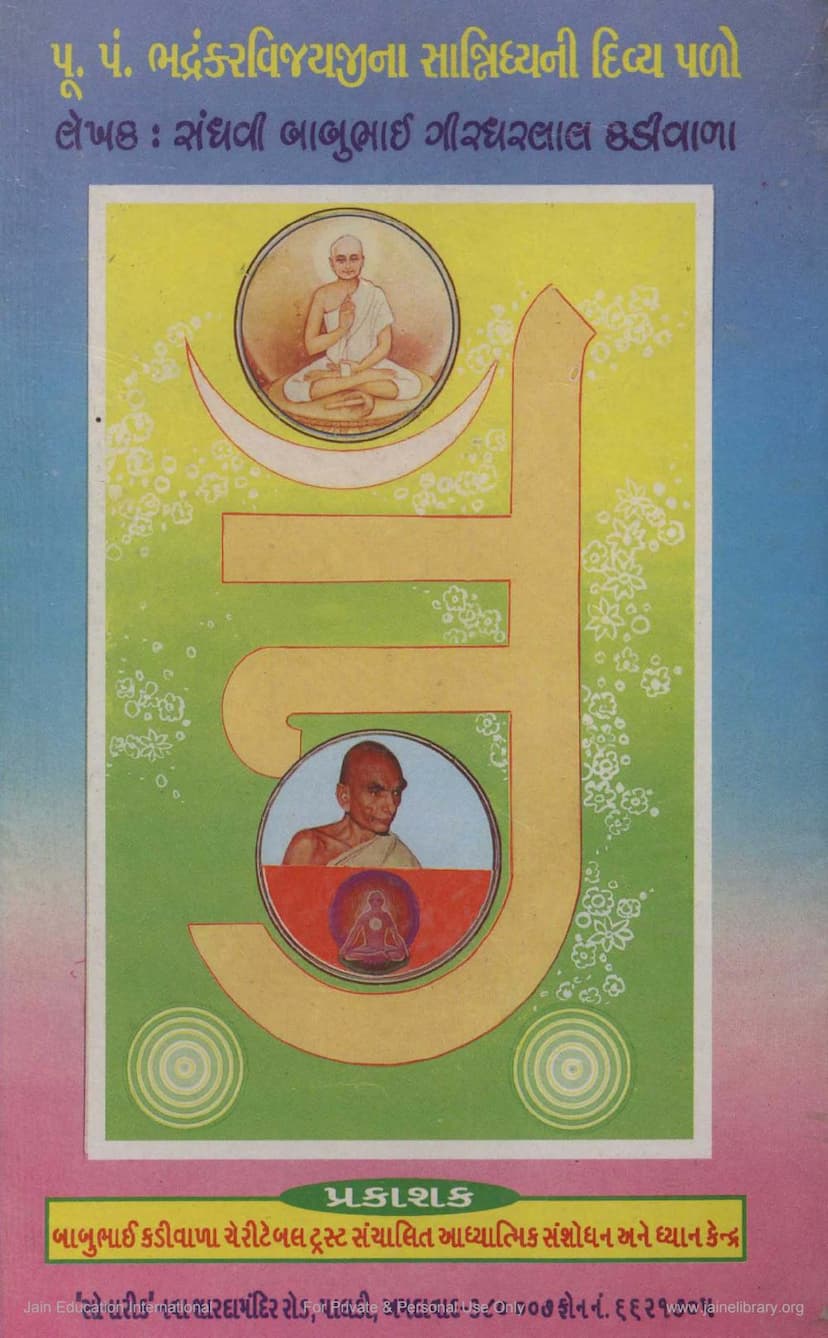Bhadrankarvijayjina Saniddhyani Divya Palo
Added to library: September 1, 2025

Summary
Here is a comprehensive summary of the Jain text "Bhadrankarvijayjina Saniddhyani Divya Palo" by Babubhai Girdharlal Kadiwala:
Book Title: Bhadrankarvijayjina Saniddhyani Divya Palo (Divine Moments in the Proximity of Bhadrankar Vijayji) Author: Babubhai Girdharlal Kadiwala Publisher: Adhyatmik Sanshodhan ane Dhyan Kendra Catalog Link: https://jainqq.org/explore/004540/1
Overview:
This book is a collection of spiritual experiences and teachings shared by the author, Babubhai Kadiwala, during his close association with the revered Jain monk, Pandit Bhadrankar Vijayji Maharaj (hereinafter referred to as Pujya Gurudev). The work aims to guide seekers towards devotion and meditation, with the ultimate goal of self-realization and liberation. It is presented as an "Amrut Kumbh" (pot of nectar) of experiences gained in the Guru's divine presence.
Core Themes and Structure:
The book is structured into several parts, detailing various aspects of spiritual practice, philosophical insights, and personal encounters with Pujya Gurudev. The central theme revolves around the profound impact of the Guru's guidance on the author's spiritual journey and the practical application of Jain principles.
Key Sections and Concepts:
-
The Guru's Guidance: The author expresses deep gratitude and reverence for Pujya Gurudev, describing him as a source of spiritual illumination, peace, and profound wisdom. Pujya Gurudev is portrayed as someone who not only understood scriptures but also experienced their essence, radiating divine knowledge and love. His teachings emphasized the realization of the self and the path to God-realization.
-
The Power of Namokar Mahamantra: A significant portion of the book is dedicated to the practice and profound benefits of the Namokar Mahamantra. Pujya Gurudev's deep devotion to this mantra is highlighted, and the author explains its power in overcoming obstacles, purifying the soul, and connecting with the divine. Various methods of mantra recitation and meditation, including visualization of letters and their divine energies, are discussed.
-
The Essence of Jain Philosophy: The text delves into fundamental Jain principles, often explaining them through the Guru's unique perspective.
- Upyoga (Consciousness/Activity): Explained as the intrinsic characteristic of the soul, distinct from the physical body.
- Parasparopagraho Jivanam (Mutual Dependence of Souls): Emphasizing the interconnectedness of all beings and the importance of fostering friendly relationships.
- Dravya, Guna, and Paryaya: The concepts of substance, qualities, and modes are explored, highlighting the eternal nature of the soul amidst changing states.
- The Four Mothers (Aadya Matrikas): The text elaborates on the spiritual significance of the alphabet (Varnamatruka), the Namokar Mahamantra (Punyamata), the five samitis and three guptis (Dharmamata), and the tri-padi (essence of Vedic mantra) as the mother of meditation (Dhyanamata).
- The Importance of Shrut (Scriptural Knowledge): The author stresses the need for grounding spiritual practice in scriptural wisdom, emphasizing that true realization comes from understanding and integrating the teachings.
-
Spiritual Practices:
- Dhyana (Meditation): Various meditation techniques are described, including focusing on the Namokar mantra, visualizing the Siddha-chakra, and contemplating the nature of the soul. The importance of consistency, proper posture, and controlled breathing is also mentioned.
- Upasana (Devotion): The text highlights the multifaceted nature of devotion, encompassing prayer, contemplation, and sincere surrender to the divine.
- Tapa (Austerity): Mentioned as a means of purifying the body and mind to aid in spiritual progress.
- Samyama (Self-Control): The control of senses and emotions is presented as crucial for spiritual advancement.
-
The Guru's Teachings on Specific Topics:
- The Goal of Life: To attain self-realization and merge with the divine.
- The Role of the Guru: The Guru is seen as a guide, a representative of the Tirthankaras, and a conduit to divine grace.
- The Nature of Reality: Distinguishing between the external world (objective reality) and the internal realm of consciousness (ideal reality).
- Karma and Rebirth: The influence of karma and the planning for future lives are discussed, emphasizing the importance of current actions.
- The Power of Positive Thinking: The influence of thoughts on one's destiny is highlighted.
- Maitri (Friendship/Love): The cultivation of universal love and compassion is presented as a path to spiritual growth.
- The Significance of the Namokar Mantra: Its profound spiritual power and its role in connecting with the divine are extensively discussed.
- Siddha-chakra: The meditative focus on the Siddha-chakra, with its intricate symbolism, is explained as a powerful tool for spiritual elevation.
- Varnamatruka (Alphabet): The meditative practice involving the Sanskrit alphabet is presented as a path to enhancing spiritual knowledge and intelligence.
- Kundalini and Chakra Meditation: While rooted in Jain tradition, the text subtly touches upon yogic concepts like Kundalini awakening and chakra balancing, interpreting them within a Jain spiritual framework.
-
Personal Anecdotes and Discourses: The book is interspersed with personal anecdotes and dialogues between the author and Pujya Gurudev, illustrating the practical application of spiritual principles in daily life. These include instances of overcoming despair, finding peace, and experiencing divine grace.
-
The Ideal Reality: The book emphasizes that the true reality lies within the self, and through proper spiritual practice, one can realize their innate divine potential.
Conclusion:
"Bhadrankarvijayjina Saniddhyani Divya Palo" is a devotional and inspirational work that aims to provide readers with practical guidance for their spiritual journey. It underscores the importance of the Guru's role, the power of mantra and meditation, and the underlying unity of all spiritual paths in leading towards self-realization and ultimate liberation. The author's deep reverence for Pujya Gurudev and his sincere effort to share these profound experiences make the book a valuable resource for spiritual seekers.